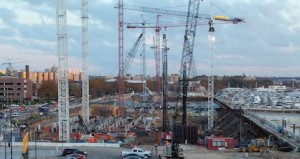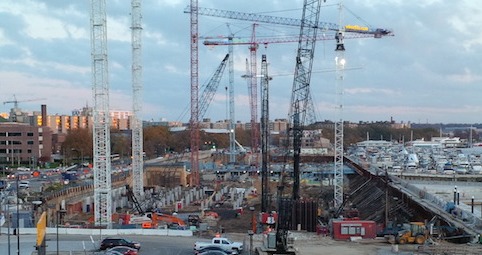 Well, not really…some explanation is in order.
Well, not really…some explanation is in order.
The bearing capacity is the primary design parameter for proportioning shallow foundations (i.e. footings and mats). If the average pressure applied by a footing is less than the allowable bearing capacity, then the footing area is adequate. This method has been used for over a century and actually predates soil mechanics. Empirical “safe” bearing capacities were provided in many codes and reference handbooks in the late nineteenth century.
The classic mathematical model for bearing capacity is the equation derived by the “father of soil mechanics”, Karl Terzaghi. It assumes a shear failure of the soil supporting the foundation and accounts for soil strength below the footing, as well as the embedment of the footing below ground. In modern terms, it estimates the ultimate strength of the ground supporting the footing, normalized by bearing area.
While all civil engineering students learn the Terzaghi equation, it has numerous problems. It requires various coefficients that are themselves correlations. In addition, accounting for groundwater below the footing can be complicated. More importantly, you need a priori knowledge of the depth and width of the footing to use it. This information is not typically available to the geotechnical engineer when preparing the geotechnical report.
The Terzaghi equation also does not account for settlement, since it is a model of the strength limit state of the foundation soil. However, most foundation failures are due to settlement, that is, they are serviceability failures. Traditionally, geotechnical engineers have attempted to account for serviceability through the factor of safety – a conceptually questionable approach – or through a separate analysis. A settlement-based allowable bearing capacity can be determined, but you have to know the absolute and differential settlement tolerance of the structure. This is often not available to the geotechnical engineer.
So how is the bearing capacity determined in real life? It is estimated, often very conservatively. Alternatively, modern building codes provide presumptive bearing capcities, but they are extremely low, representing lower bound vales. This should incentivize proper geotechnical exploration and analysis. However, a testing agency can provide bearing capacity recommendations in its geotechnical report at effectively no cost by assuming a value that approaches the code presumptive limits. There is little risk of failure because the recommendation is extremely conservative. Meanwhile, the project owner thinks he got a bargain by saving several thousand dollars on the geotechnical services, not know that he is going to pay for two or three times the necessary foundation capacity.
But I digress. So how might your building be weightless? The various means for calculating bearing capacity provide an ultimate or allowable pressure that will, respectively, result in a shear failure or displacement of a particular magnitude. However, these values are typically reported in terms of the applied loads in excess of the overburden pressure. Therefore, if you excavate for a foundation, the weight of the soil removed can be essentially added to the bearing capacity (although the weight of the foundation and any backfill must be added to the applied load).
Let’s assume you are building a five-story office building with a basement. If it is a steel building, the combined dead load and live load will be of the order of 150 pounds per square foot (psf). For five stories and a roof, the total building load will be about 900 psf. Let’s also assume the building will have a basement resulting in the excavation of eight feet of soil. If a relatively average weight of soil is assumed, say 115 pounds per cubic foot, the weight of the soil excavated is 920 psf. Therefore the soil feels a net unloading of 20 psf. In other words, as far as the soil knows, your building is weightless.
Of course in this scenario, you will still need a complete gravity load path and a foundation system. Also by comparing the building area load with the unloading of the foundation, I have implied that the building will have a mat foundation, which might not be the most appropriate system in a real example. But note that independent of the actual bearing capacity in this example, the building can be built on shallow foundations, without piles, without ground improvement, and without settlement, as long as the footing area is large enough and the subgrade is prepared properly.
While a useful concept, the bearing capacity is not a real physical parameter. In reality, it is a legacy system that provides a convenient mean of summarizing multiple conceptual and mathematical models that describe the soil-structure interaction of a shallow foundation system. It is a site parameter that includes information about the structure that is to be built, including the depth of any basement.
When a parameter like bearing capacity is treated like a material property that can be measured by testing, rather than the product of geotechnical and foundation engineering analysis and judgment, the resulting foundation will inherently be unnecessarily expensive. As shown in a very simple example, considering the configuration and actual demands of the structure allows for a more efficient approach. However, attaining a more efficient design requires that geotechnical and foundation engineering be coordinated with the overall site conditions and the building design. An adequate scope and, of course, fee, is necessary to accomplish this, but this investment can be returned several times over in reduced cost and risk during construction.
The information and statements in this document are for information purposes only and do not comprise the professional advice of the author or create a professional relationship between reader and author.
